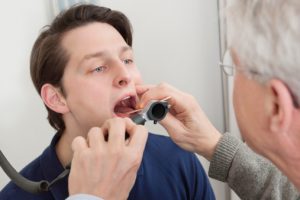 Obstructive sleep apnea risk may be linked to the size of tongue and tonsillitis. The findings of the study found that dentists may be able to provide valuable information on how someone sleeps, as they are constantly looking into their patients’ mouths and can observe an enlarged tongue or tonsillitis.
Obstructive sleep apnea risk may be linked to the size of tongue and tonsillitis. The findings of the study found that dentists may be able to provide valuable information on how someone sleeps, as they are constantly looking into their patients’ mouths and can observe an enlarged tongue or tonsillitis.
The study found that an oversized tongue and tongue indentations are a risk factor for obstructive sleep apnea, and obese patients are 10 times more likely to experience such symptoms compared to non-obese patients.
Advertisement
Dentists do not diagnose sleep apnea, but they can determine if a person has an enlarged tongue or tonsils, which can contribute to sleep apnea. Lead researcher Thikriat Al-Jewair said, “Dentists see into their patient’s mouths more than physicians do and the signs are easy to identify.
The study looked at 200 patients at dental clinics and the researchers studied the patients for obstructive sleep apnea by using the Berlin Questionnaire. Participants were screened for sleep apnea risk factors, including body mass index, neck circumference, blood pressure, size of the tongue, tonsils, and uvula.
Twenty-three percent of the participants were at risk of obstructive sleep apnea and in that group, 80 percent were male.
Common risk factor, aside from obesity and neck circumference, was a large tongue or tonsils.
Advertisement
Future research will include larger sample sizes with varying age groups.
Other obstructive sleep apnea risk factors
Obstructive sleep apnea is a sleep disorder in which a person stops breathing for split seconds numerous times throughout the night. Obstructive sleep apnea is a preventable condition, as many lifestyle factors can be changed in order to lower one’s risk of developing sleep apnea. Some other obstructive sleep apnea risk factors include:
- Obesity – those who are overweight or obese have a seven times greater risk of developing OSA
- Neck circumference – obese people also have larger necks, but those who with a muscular build have large necks, too. Anyone with a neck circumference over 17 inches for men and over 15 for women is considered to be at higher risk for OSA
- Age – sleep apnea is more common with age
- Family history – individuals with a family history of sleep apnea are more likely to develop it themselves
- Alcohol use – alcohol relaxes the muscles in the throat and mouth, thus contributing to a greater blockage
- Race – differences in ethnic airways put some races at a higher risk than others
- Smokers – smokers have double the risk for sleep apnea
- Gender – men are more likely than women to develop sleep apnea.
As you can see, many of these risk factors are changeable, which means you can work actively towards lowering your risk of developing obstructive sleep apnea.
